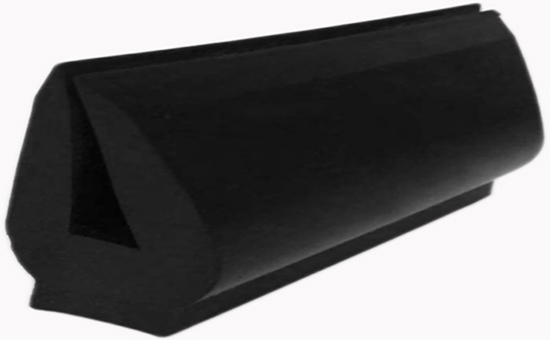
Extrusion, calendering and vulcanization are important processing steps in the production of EPDM reclaimed rubber products. Different reclaimed rubber products have different conditions for extrusion, calendering, vulcanization and other processes. Rubber product manufacturers need to reasonably set the process conditions according to actual needs. .
3. EPDM reclaimed rubber product processing process - extrusion, calendering
Extrusion is extrusion, which is the process of making the rubber material pass through the action among the barrel wall and the screw of the extruder to continuously make semi-finished products of different shapes; calendering is the extrusion of the rubber material through the gap among the rollers that rotate relative to the special calendering equipment. The process of pressing and extending into a film with certain specifications and shapes. When using EPDM reclaimed rubber 2ELYY915 or EPDM/EPDM reclaimed rubber to produce rubber products, EPDM reclaimed rubber products with various shapes and complex cross-sections such as rubber tubes and sealing strips are extruded.
In actual production, EPDM rubber and EPDM reclaimed rubber have fast extrusion speed and small shrinkage rate. Type temperature 90-140 ℃. The EPDM compound can be continuously calendered at a temperature of 80-120°C. It should be noted that if the calendering temperature of the EPDM rubber compound is too low, the shrinkage rate of the rubber compound will increase, and it is easy to generate air bubbles. Therefore, the calendering temperature of the EPDM reclaimed rubber product containing the EPDM original rubber should not be too low.
4. EPDM reclaimed rubber product processing process - vulcanization
Vulcanization is the last and most important process in the production of EPDM reclaimed rubber products. The rubber material is cross-linked through the intermolecular cross-linking of the raw rubber to form a three-dimensional network structure. Mechanical behavior. In actual production, vulcanization system design, vulcanization conditions (vulcanization temperature and time, vulcanization pressure, vulcanization medium, etc.) settings will affect the EPDM reclaimed rubber vulcanizate index, and then affect the performance and life of rubber products.
(1) Vulcanization system: When EPDM reclaimed rubber or EPDM rubber/reclaimed rubber is used to produce rubber products, sulfur vulcanization system, peroxide vulcanization system and resin vulcanization system can be selected. Among them, the sulfur vulcanization system is more common. The sulfur donor vulcanization system can improve the compression deformation and thermo-oxidative aging properties of the EPDM reclaimed rubber vulcanizate, and the EPDM reclaimed rubber peroxide vulcanizate has better heat resistance and aging resistance. , The resin vulcanization system can realize low temperature vulcanization.
(2) Vulcanization conditions: The vulcanization of EPDM reclaimed rubber needs to be completed after a certain period of time at a specific temperature and pressure. In actual production, EPDM reclaimed rubber is generally vulcanized at a temperature of 150-180 °C, and the vulcanization time required for thin-walled EPDM reclaimed rubber products is 30-50 °C; Shorten by half. The function of vulcanization pressure is to make the EPDM reclaimed rubber disperse and fill the model. By improving the wear resistance and aging resistance of the rubber, the softening temperature is generally low, and the vulcanization pressure is relatively low. The common pressure sources are water pressure and steam pressure. , compressed air, etc.
(3) Positive vulcanization time: Under certain vulcanization temperature and pressure conditions, there will be an optimal vulcanization time, that is, positive vulcanization time: if the time is too long, oversulfur will occur, and if the time is too short, undersulfur will occur. Both oversulfur and undersulfur will lead to regeneration. The performance of rubber products decreased. The thickness of the finished product of EPDM reclaimed rubber product is below 6mm, and the curing time of the finished product is the same as the positive curing time of the test piece; when the thickness of the finished product of EPDM reclaimed rubber product is greater than 6mm, the curing time lags by 1-1.5min for each additional 1mm of thickness; Skeletons, etc., require additional lag time.
(4) Vulcanization medium: The process of converting linear rubber macromolecules into a three-dimensional network structure under a certain temperature and pressure of EPDM reclaimed rubber requires heating. The material that transfers heat energy is the vulcanization medium, and its main function is heat transfer or Pressurization, the common ones are saturated steam, hot air, superheated water, superheated steam, infrared, far infrared, microwave, etc.
When using EPDM reclaimed rubber to produce rubber seals, seals, rubber pipes, waterstops, conveyor belts, air-conditioning pipes, wire and cable sheaths, automotive interiors, sports facilities and other rubber products, product manufacturers must strictly control each A processing process, the editor will continue to share with you the precautions of various processing processes.
Exclusive original article [commercial authorization] reprint, excerpt and excerpt in any form are prohibited without written authorization. Focus on Hongyun rubber: learn the process formula and raw material technology of producing rubber products from recycled rubber to help you reduce costs and increase profits